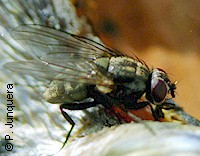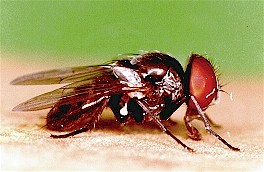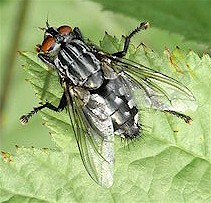Houseflies are the nuisance or filth fly par excellence. But there are numerous other non-biting fly species that can have seasonal, local or regional importance in or around livestock facilities such as stables, barns, poultry houses, piggeries, dairy farms, feedlots, etc.

They are called filth flies because they develop in filthy environments such as animal feces, carcasses, decaying kitchen materials, garbage, etc. They are also called nuisance flies because they can be rather annoying to humans and animals, but do not bite, i.e. they don't suck blood.
Strictly speaking most nuisance and/or filth flies are not parasites, at least not obligate parasites, because they do not live at the expense of other organisms and can complete their life cycle in the environment.
A few species are facultative parasites, i.e. under certain circumstances they can lay eggs on living humans or animals, which develop to myiases. But as houseflies, filth and nuisance flies are all mechanical vectors of numerous pathogens and contaminant microbes.
Main species of filth and nuisance flies
The false stable fly (Muscina stabulans) is a cosmopolitan fly in and around livestock operations, much less frequent in urban areas. It looks very much like a housefly, but is slightly larger (8 to 12 mm long) and bulkier. In countries with a cold winter it appears usually in early spring, before houseflies. In tropical and subtropical regions it is active the whole year through. It feeds on any kind of feces and carcasses. Larvae develop in decaying plant or animal materials. The life cycle lasts between 3 and 5 weeks. Muscina flies have the disgusting habit of defecating in food, which explains their capacity of acting as vectors of pathogens and contaminants. Muscina stabulans is also interesting for forensic entomology in order to determine when a person died based on the arthropod species found on its cadaver. There are about 30 additional species of the genus Muscina worldwide.

Lesser houseflies (Fannia spp) are also cosmopolitan flies in and around livestock operations worldwide. Fannia canicularis is one of the most common species. It looks like a housefly but is clearly smaller (4 to 7 mm long) and a typical behavior consists in hovering and circling inside rooms, with sudden changes of the flying direction. It feeds on any kind of decaying plant or animal material, including carrion. Another significant species is Fannia scalaris, the latrine fly, which is capable of producing human myiases, can be quite abundant in urban environments and deposits eggs preferably on cadavers, which makes it interesting for forensic entomology. There are about 300 hundred other species of the genus Fannia.
Black garbage or dump flies (Ophyra spp) are also cosmopolitan flies that are often found in and around human garbage and dumps. Adult flies prefere They have a metallic black color and are smaller than houseflies, about 5 to 8 mm long. They breed on all kinds of manure and decaying organic material. A particular feature of these flies is that their larvae are strong predators of housefly and are sometime used for biological control of houseflies. There are about 20 Ophyra species worldwide.
Flesh flies(Sarcophaga and other genera) is a family of small to large flies (0.3 to almost 2 cm long) with characteristic longitudinal gray stripes on the thorax. Larvae of flesh flies are carnivorous and develop in all kinds of carrion, dung and decaying organic material, but also on open wounds of animals. Flesh flies are ovoviviparous, i.e., they do not deposit eggs on the substrate, but already hatched maggots. Such larvae can also be predacious of larvae of other species developing in the same substrate. They can also cause cutaneous myiases on livestock and other mammals, and can transmit human leprosy. Flesh fly larvae are also of interest for forensic entomology. There are about 100 different genera and more than 2'000 different flesh flies species worldwide.
Click here to learn more about the general biology of insects.
Prevention and control of filth and nuisance flies

As a general rule, most measures for preventing and controlling houseflies will control and prevent filth flies as well. However, biological control measures using natural enemies of houseflies will not be efficient against most of these other filth flies because most housefly enemies are too specific. Learn more about biological control of flies and other insects.
The key to filth fly prevention is removing as effectively as possible whatever can serve as a breeding substrate for the flies (i.e. any kind of organic material such as manure, feed or silage waste, remains of hay, straw, bedding, crashed eggs, carcasses, etc.). If it cannot be removed, it must be kept dry. To ensure this, plumbing and hosepipes must be leak-free and regularly maintained, and rainwater must be properly drained. Air circulation over accumulated manure must be favored, e.g. with electric fans. The way to implement this strongly depends on type and size of the operation and on the surface available for manure or waste disposal.
Chemical prevention and control with ADULTICIDES
Spraying insecticides on the surfaces preferred by the flies for landing (walls, ceilings, posts, fences, etc.) can be quite effective. Most products for surface spraying kill the adult flies by contact (so-called adulticides). A few products are not sprayed but painted on such surfaces (paint-on insecticides), often after being mixed with sugar. They contain oral insecticides, i.e., the flies have to feed on them. Most products for treating surfaces contain classic veteran insecticides such as:
- Organophosphates, e.g. diazinon, chlorpyrifos
- Carbamates, e.g. propoxur, carbaryl
- Synthetic pyrethroids, e.g. cypermethrin, deltamethrin, permethrin
- Neonicotinoids, e.g. imidacloprid
- Phenylpyrazoles, e.g. fipronil
Depending on the active ingredient of the product and the type of surface (wood, plastic, metal, etc.) the applied insecticide will remain active for several weeks (residual effect). Efficacy will be progressively reduced by regular washing and sprinkling, and by dust and dirt that deposits on the treated surfaces.
Baits with insecticides can also be quite effective. They are available as scatter baits, already applied to cardboard or paper strips, etc. These baits also contain classic veteran insecticides such as those for surface spraying, but also newer ones such as spinosad and metaflumizone. Baits are often combined with fly attractants, mostly Z-9-tricosene, a sex pheromone released by females to attract males. Most baits also have a bitterant, i.e. a substance that makes the bait extremely bitter to prevent human ingestion. However, most baits are optimized for controlling houseflies and may not be as effective against other filth fly species.
Fumigation of insecticides makes only sense to immediately reduce an excessive fly population indoors. But it kills only those flies that are caught in the mist during application. Fumigation has no residual effect. Fumigation usually requires special equipment. To be effective air circulation must be interrupted in the fumigated premises. Fumigation may require emptying the premises from animals to prevent poisoning. Products for fumigation contain mostly veteran insecticides such as organophosphates and synthetic pyrethroids, often mixed with synergists.
It is never a good idea to directly treat the animals with insecticides in order to kill adult filth flies. (e.g. with dips, sprays, pour-ons, ear-tags, dusts, etc.). First, because only a few flies would be killed: filth flies land only very shortly on the animals, if at all, since they feed on any organic material, which they can find in excess off the animals. Second, because many insecticides for surface treatment are only approved for off-animal use, and treating livestock with such products bears the risk of poisoning or of illegal residues in meat, milk or eggs.
There are no synthetic chemical repellents capable of keeping filth flies away from livestock, manure or organic waste material.
Chemical prevention and control with LARVICIDES
Larvicides kill the immature stages of the flies in their breeding environment. Products for this purpose are mostly applied directly on the manure heaps, or for spraying floors, drains, crevices, etc. where fly maggots could hide. This process is sometimes called larviciding. Such products are available as sprays, granules, powders, etc. Besides classical veteran larvicides (e.g. organophosphates, carbamates, synthetic pyrethroids, neonicotinoids) that kill the maggots, insect development inhibitors are also used (e.g. cyromazine, diflubenzuron, triflumuron, etc.) that do not immediately kill the maggots, but interrupt their development to adult flies. The drawback of such products is that they are also detrimental to the beneficial dung fauna, with the exception of cyromazine that is quite specific for houseflies.
In some countries there are larvicides available as feed additives for poultry and horses (e.g. with cyromazine) and also for cattle and swine (e.g. with diflubenzuron). After ingestion the active ingredient is excreted unchanged in the feces and prevents the development of flies in the manure. Since all the feces are treated it is a very effective means for prevention and control of flies that develop in animal excrements.
However, those filth flies that prefer carrion for breeding (e.g. flesh flies) may not be adequately controlled with larvicides.
| If available, follow more specific national or regional recommendations or regulations for filth fly control. |
Click here to learn more about surface and environmental treatments.
Insecticide resistance of filth and nuisance flies
The good news is that resistance is not a serious problem with most filth flies. There are reports on populations of the lesser housefly (Fannia canicularis) resistant to insecticides, but it is certainly not a widespread problem as it is for houseflies.
Learn more about parasite resistance and how it develops.